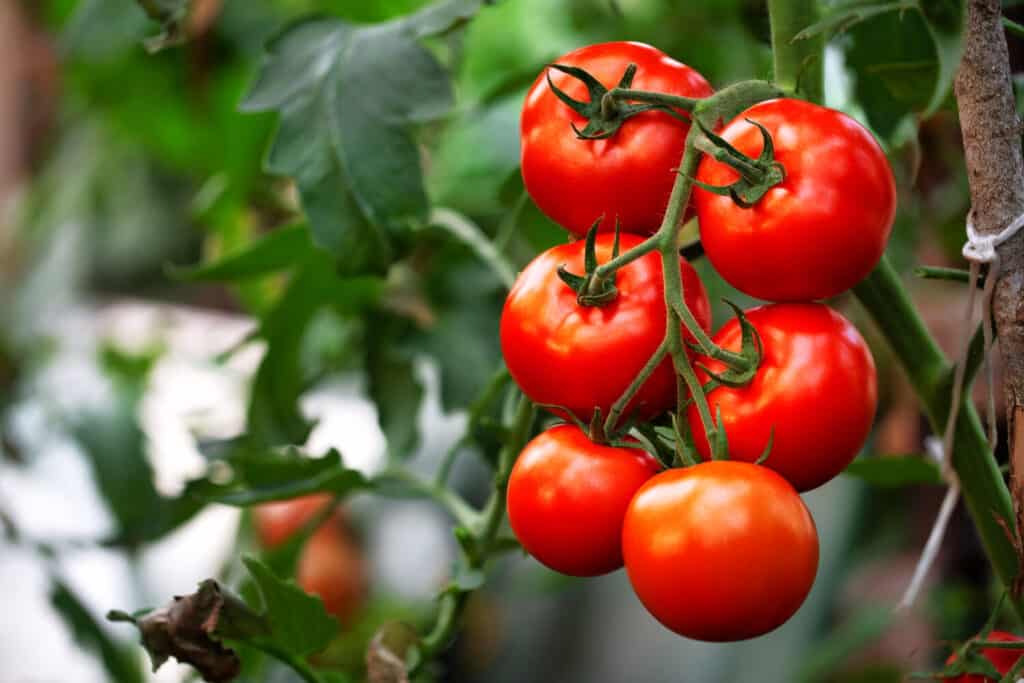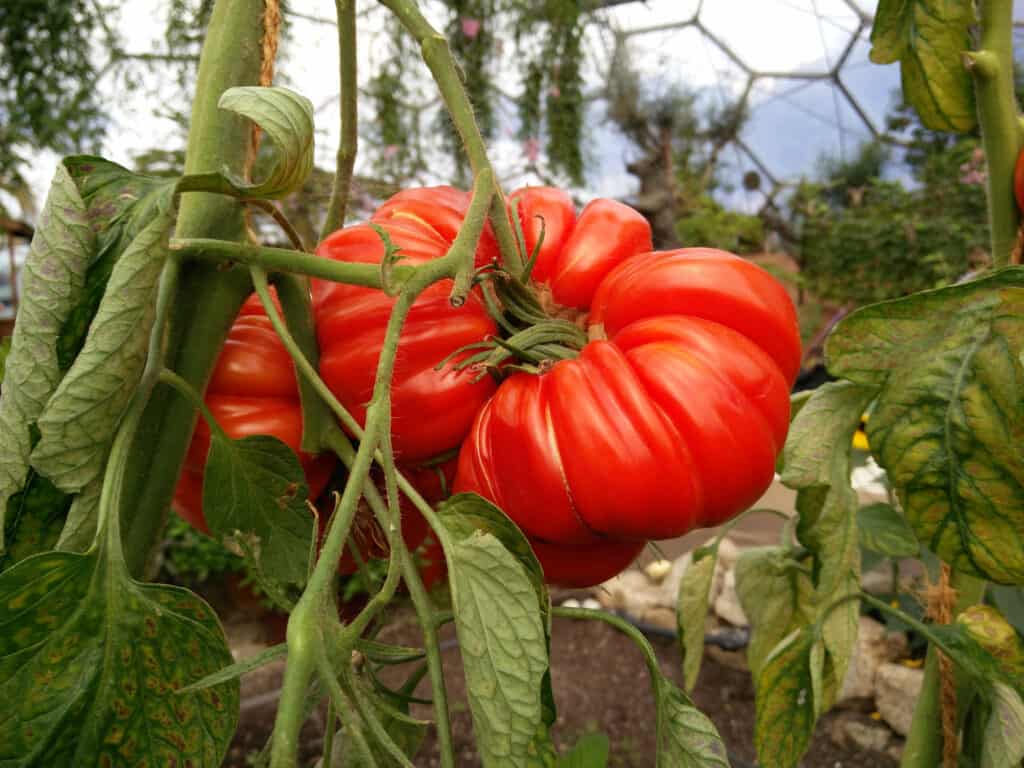Get ready, tomato enthusiasts of Massachusetts! The sun-soaked secrets of prime tomato growth are about to be unveiled. When it comes to those plump, juicy gems, timing is everything. The Bay State’s climate has its rhythm, and to make your tomatoes thrive, you’ve got to dance to its beat.
So, what’s the scoop on the sweet spot for tomato planting? Let’s find out! But first, let’s take a look at whether or not tomatoes are a major crop for the state of Massachusetts.
Are Tomatoes a Popular Crop in Massachusetts?
When it comes to agriculture in Massachusetts, tomatoes have secured a spot as a popular crop. This versatile fruit (or vegetable, depending on what you’re feeling) has established itself as a staple in the state’s farming practices.
Climatic Favorability
The climate in Massachusetts plays a significant role in the success of tomato cultivation. With warm summers and a growing season that typically lasts from May to September, the state provides an environment conducive to tomato growth. Farmers capitalize on this climate to produce a wide variety of tomato types, including heirloom and hybrid varieties.
Local Demand and Consumption
The popularity of tomatoes is also evident in the local demand and consumption patterns. Tomatoes are a key ingredient in various dishes that hold a special place in Massachusetts’ culinary culture, such as clam chowder and baked beans. Additionally, the farm-to-table movement has encouraged the use of locally-grown produce, boosting the demand for Massachusetts-grown tomatoes.
Economic Impact
Tomato cultivation has not only found favor among consumers but has also yielded economic benefits for the state. Local farmers find tomatoes to be a profitable crop due to their high demand and relatively low production costs. This contributes to the overall economic health of the state’s agricultural sector.
Challenges and Sustainability
While tomatoes thrive in Massachusetts, challenges do exist. Pests, diseases, and adverse weather conditions can impact yields. To address these challenges, farmers employ integrated pest management strategies and adopt sustainable agricultural practices. This ensures the continued success and availability of locally grown tomatoes.

Tomatoes may not be Massachusett’s main crop, but it is still possible to grow them in the state with ease.
©eugenegurkov/Shutterstock.com
Peak Times to Start Growing Tomatoes in Massachusetts
Planting tomatoes in Massachusetts requires careful timing, taking into account the state’s diverse hardiness zones. Different regions experience varying climates, influencing the optimal times for planting tomatoes. By understanding these variations, gardeners can maximize their tomato yields and success.
Understanding Hardiness Zones
Massachusetts is divided into multiple hardiness zones, which are determined by the average minimum winter temperature. These zones provide valuable information about the climate conditions a region typically experiences. In Massachusetts, zones range from 5b in the western parts to 7a in the southeastern coastal areas.
Early Preparation in Zone 5b
In the western parts of Massachusetts, characterized by Zone 5b, the climate tends to be cooler. Gardeners in this zone should start preparing for tomato planting by early April. As the last frost date occurs later in this region, usually around mid-May, starting tomato seeds indoors becomes essential. By sowing seeds indoors around 6 to 8 weeks before the last frost, gardeners can ensure sturdy seedlings are ready for outdoor transplanting.
Optimal Planting in Zone 6a
Zone 6a, covering a considerable portion of central Massachusetts, offers a slightly longer growing season than Zone 5b. The last frost date typically falls between late April and early May. Gardeners in this zone can begin planting tomato seedlings directly outdoors around mid-May, as the soil starts to warm up. For those who prefer indoor seed starting, the timing remains similar to Zone 5b, to transplant outdoors by early June.
Balancing Timing in Zone 6b
The eastern part of Massachusetts, including Boston, falls under Zone 6b. Here, the maritime influence moderates temperatures, leading to milder winters compared to the western regions. With a last frost date usually around mid-April to early May, gardeners can take advantage of the relatively longer growing season. Starting tomato seeds indoors in late March or early April ensures robust seedlings for transplanting in late May or early June.
Warm Coastal Conditions in Zone 7a
The southeastern coastal areas of Massachusetts, encompassing Zone 7a, experience relatively warmer conditions due to the proximity to the Atlantic Ocean. With a last frost date often occurring in early to mid-April, gardeners in this zone can initiate outdoor tomato planting as early as late April. However, starting seeds indoors around late February to early March can provide a head start, yielding strong seedlings for outdoor transplantation by early May.
Adapting to Variability
While hardiness zones provide valuable guidelines, it’s important to note that weather can be unpredictable. Unexpected late frosts or unusually cold springs can impact planting schedules. Gardeners are advised to monitor local weather forecasts and consider protective measures like row covers or cloths to shield young tomato plants from sudden temperature drops.

Tomatoes can grow well in most of the hardiness zones in Massachusetts.
©Graham Corney/Shutterstock.com
Are There Hardiness Zones in Massachusetts Where Tomatoes Can’t Grow?
While most parts of Massachusetts offer suitable conditions for tomato cultivation, extreme microclimates or unfavorable soil conditions might pose challenges. Areas with consistently cold temperatures, limited sunlight, or poorly drained soils may not be the best fit for tomato plants. Overall, understanding the specific hardiness zone of a region can guide gardeners in determining the feasibility of growing tomatoes and adopting appropriate cultivation strategies.
When to Harvest Tomatoes in Massachusetts
Harvesting tomatoes at the right time is crucial to enjoy their optimal flavor and texture. In Massachusetts, the diverse hardiness zones contribute to variations in the peak times for tomato harvesting.
Zone 5b: Western Massachusetts
In the western parts of Massachusetts, falling under Zone 5b, the growing season is slightly shorter due to cooler temperatures. Gardeners should aim to start harvesting tomatoes around late July or early August. The ideal time to pick tomatoes is when they have reached full color, are firm to the touch, and easily detach from the vine. Be sure to harvest before the first fall frost arrives, which can occur as early as mid-September in this zone.
Zone 6a: Central Massachusetts
Zone 6a, covering central Massachusetts, provides a more extended growing season. Gardeners in this region can typically start harvesting tomatoes in late July and continue through September. As with other zones, look for mature tomatoes that are fully colored and slightly soft when gently pressed. It’s wise to keep an eye on weather forecasts in early fall and consider protecting plants if frost is expected.
Zone 6b: Eastern Massachusetts
In Zone 6b, including eastern Massachusetts, the maritime influence leads to milder temperatures. This zone allows for an even longer harvesting window, beginning in mid-July and extending through September. Frequent checks for ripe tomatoes are essential to ensure they are picked promptly. As the fall season approaches, having frost protection measures in place can safeguard the tomato plants and extend the harvesting period.
Zone 7a: Southeastern Coastal Areas
The southeastern coastal areas, designated as Zone 7a, experience the warmest conditions in Massachusetts. Gardeners in this zone can start harvesting tomatoes as early as July and continue well into October. The extended warm weather allows for an abundant harvest. Tomatoes should be harvested when they exhibit their characteristic color and have a slight give when gently squeezed.
Tomato Varieties That Grow Well in Massachusetts
In cooler areas like western Massachusetts, early maturing varieties such as ‘Early Girl’ and ‘Stupice’ are well-suited, as they can ripen before the first frost. In central and eastern regions, a wider range of varieties can thrive due to the longer growing season. Indeterminate types like ‘Brandywine’ and ‘Cherokee Purple’ produce large, flavorful fruit throughout the season.
In the southeastern coastal zones, the warmer climate supports even more tomato options. Heat-loving varieties like ‘Sun Gold’ and ‘Big Beef’ excel here, yielding abundant crops. Cherry tomatoes like ‘Sweet Million’ and ‘Black Cherry’ also thrive in this zone.
Adapting tomato choices to hardiness zones is crucial for successful cultivation. Paying attention to the specific climate conditions in each zone ensures that you select the right tomato varieties for your region, leading to a productive and flavorful harvest.

Larger, beefier tomato varieties can grow well in Massachusetts, especially in coastal regions.
©iStock.com/Sophie Shoults
Tips for Growing Tomatoes in Massachusetts
Growing tomatoes at home in Massachusetts can be a rewarding endeavor, but it requires careful consideration of the state’s diverse hardiness zones. With varying climates across the regions, here are some essential tips and advice for a successful tomato harvest!
Starting Indoors for an Early Start
For all zones, starting tomato seeds indoors offers a head start. Begin indoor seeding around 6 to 8 weeks before the last expected frost date in your specific zone. This practice ensures strong and healthy seedlings for outdoor transplanting.
Transplanting Outdoors Carefully
Transplant outdoor seedlings when the soil has warmed up to around 60 degrees F. This temperature is ideal for root development. Be mindful of the last frost date in your zone and consider using protective covers in case of unexpected late frosts.
Proper Spacing and Sunlight
Plant tomato seedlings at the recommended spacing for your chosen variety. This spacing allows for good air circulation, reducing the risk of diseases. Ensure that tomato plants receive at least six to eight hours of direct sunlight daily for optimal growth and fruit production.
Soil Preparation and Fertilization
Test and amend the soil’s pH and nutrient levels as needed before planting. Incorporate organic matter like compost to improve soil structure and fertility. Follow recommended fertilization guidelines based on soil test results to promote healthy growth.
Mulching and Watering
Apply mulch around tomato plants to retain soil moisture, prevent weed growth, and maintain even soil temperatures. Water consistently, keeping the soil consistently moist but not waterlogged. Water the base of the plants rather than overhead to avoid fungal issues.
Staking and Pruning
Stake or cage tomato plants to provide support for the heavy fruit and keep them off the ground. Prune the plants by removing suckers, which are side shoots that grow between the main stem and branches. This encourages better air circulation and focuses energy on fruit production.
Pest and Disease Management
Regularly inspect tomato plants for pests such as aphids, hornworms, and tomato fruit worms. Implement integrated pest management practices to control pests without harming beneficial insects. Monitor for signs of diseases like early blight or late blight and take action promptly.
Harvesting at Peak Ripeness
Harvest tomatoes when they are fully colored, slightly soft, and easily detach from the vine. Different hardiness zones will have varying harvest times. Check for local frost forecasts and consider picking tomatoes before a potential frost to prevent damage.
The photo featured at the top of this post is © Kamila Koziol/Shutterstock.com
Thank you for reading! Have some feedback for us? Contact the AZ Animals editorial team.







